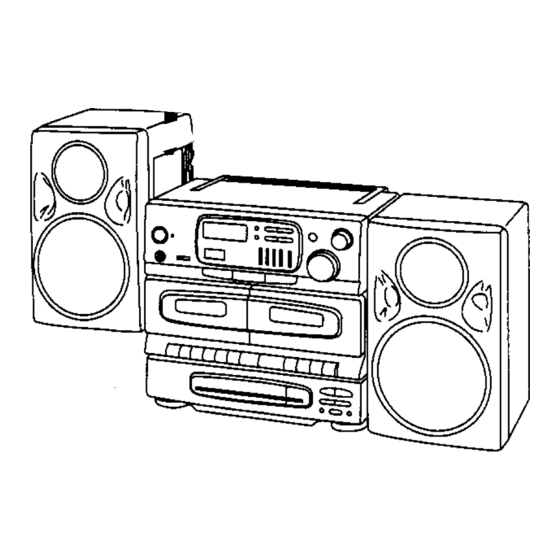Panasonic RX-DT670 Manual de Instruções - Página 20
Procurar online ou descarregar pdf Manual de Instruções para Sistema estéreo Panasonic RX-DT670. Panasonic RX-DT670 25 páginas. Portable stereo component system
Também para Panasonic RX-DT670: Manual de Instruções (24 páginas)

MIC MIXING
CASSETTE TAPES
Mixing is the combination of a voice or instrumental sound
(through a microphone connected to the mixing microphone
jack) and the sound from a CD, tape or radio.
■ Mixing playback
1. Connect the mixing microphone to the mixing micro¬
phone jack.
2. Set the desired source to playback mode.
■ Mixing recording
•With cassette tape
1. Connect the microphone to the mixing microphone jack
after reducing the volume level.
2. Insert a tape for recording in deck 1, and a tape for
playback in deck 2.
3. Press the "TAPE" button of the function select buttons.
4. Set the edit recording speed/beat proof selector to
"NOR".
5. Follow the procedure described in steps 4-5 of "Syn¬
chronized editing". (See page 19.)
•With other source
1. Connect the microphone to the mixing microphone jack
after reducing the volume level.
2. Insert a tape for recording In deck 1.
3. Set the desired source playback mode.
4. Press the record button.
•Recording through mixing microphone
1. Connect the microphone to the mixing microphone jack
after reducing the volume level.
2. Insert a tape for recording in deck 1.
3. Set the edit recording speed/beat proof selector to
"NOR".
4. Press the "TAPE" button of the function select buttons.
5. Press the record button.
Notes:
•When not using a microphone, disconnect it from
the microphone jack.
•While using the microphone, howling or squealing
may sometimes occur. When it occurs, separate
the microphone from the speaker, or decrease the
volume level.
•When the compact disc play stops or pauses while
enjoying the microphone mixing, the voice from the
speaker also stops.
■ Cassette tapes exceeding 90 minutes
These tapes are handy for their long playback and recording
time but be careful about repeatedly stopping and starting,
rewinding and fast forwarding these tapes in short intervals
as they are thin, tend to stretch and may become entangled
in the machine.
If the tape loosens, take up
the slack by turning the reel
in the proper directions.
Do not handle, or pull the
tape out of the cassette.
Notes:
•Use normal types of cassette tapes only. If other
tapes are used, you may not obtain optimum per¬
formance.
•Cassettes, both recorded and unrecorded, should
not be stored in locations with high temperature,
high humidity or direct sunlight. Never place a
recorded cassette near a magnetic source, such as
a magnet or a TV set as this may affect tape
performance.
RECORD PREVENTION TABS
Cassettes are provided with plastic tabs (as illustrated) to
prevent accidental erasing of a recording.
Recordings can be made only when the tab Is intact. There
is one tab for each side (track) of the tape. To preserve a
valuable recording, the tab(s) should be broken off with a
small screwdriver.
If you want to record on a track whose tab has already been
broken off, use attach tape to cover the hole, and record.
20
